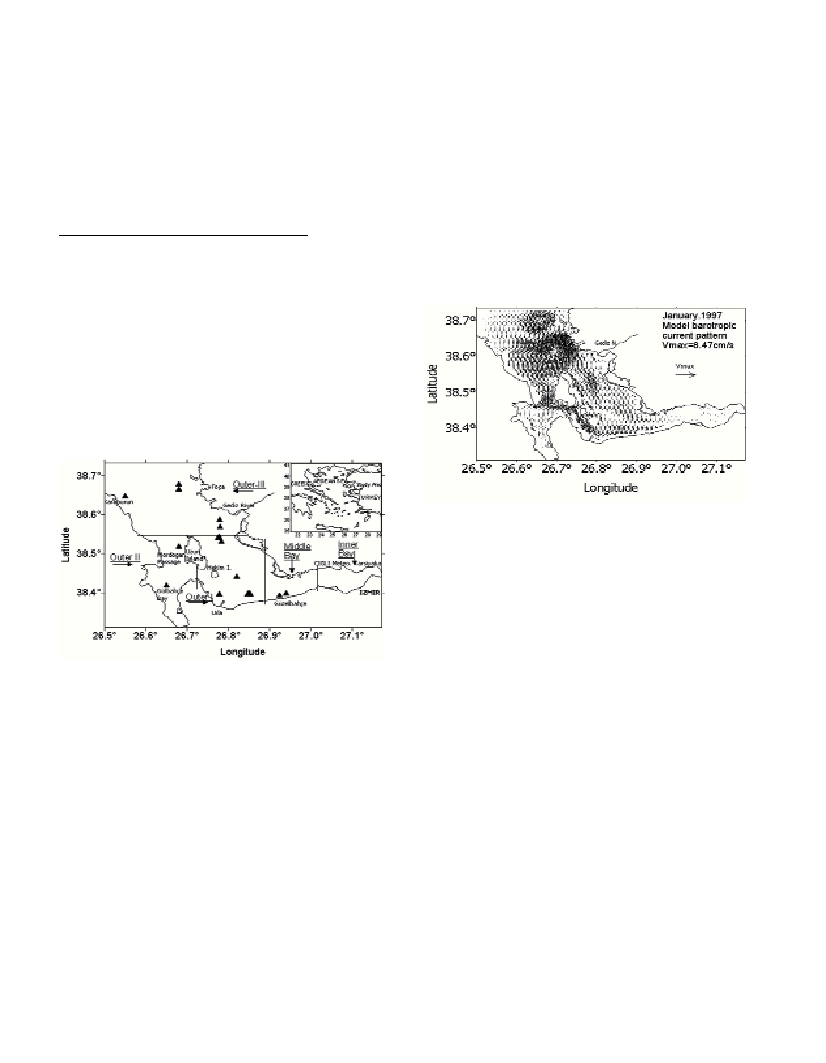Rapp. Comm. int. Mer Médit., 37,2004
133
THE WINTER CIRCULATION SYSTEM OF THE IZMIR BAY UNDER THE INFLUENCE OF WIND
AND THERMOHALINE FORCES
Idil Pazi* and Erdem Sayin
DEU Institute of Marine Sciences and Technology, Izmir, Turkey - * idil@imst.deu.edu.tr
Abstract
The aim of the study is to examine seasonal circulation pattern of the Izmir Bay under the in?uence of wind and thermohaline forces. The
general water movement characteristics in the Bay are given as a result of analysis of observed current data together with Killworths
general circulation model. The wind from north direction is constant feature. The model is forced using wind data obtained from the Çigli
Meteorological Centre. To set a realistic stratification, measured CTD data is prescribed in the model as initial condition. The wind stress
constitutes the main forcing for rotational barotropic motions in the Izmir Bay.
Keywords: circulation pattern, spectra, Izmir Bay
Common oscillations
The current measurements between 1994 and 1998 have been
performed by the Institute of Marine Sciences and Technology of
Dokuz Eylül University with the R/V K. Piri Reis. The locations of
current meters are shown in Figure 1. As a result of current and wind
spectral analysis the frequencies belong to relevant processes are
investigated. The corresponding frequencies can be analysed in four
groups. First group has daily period (5 days) related to the large-scale
cyclonic motion in the Aegean Sea. The second group is usually
affected by sun and moon, includes diurnal and semi-diurnal tides
periods. The most important tides are diurnal-luni solar (K1), diurnal-
principal solar (P1), semi-diurnal luni solar (K2) and semi-diurnal
principal solar (S2). The third group considers the inertial oscillations
and the last group is seiches. But last cannot be resolved by hourly
collected data (1).
Fig. 1. The location of current meters
Winter current pattern
The circulation system of the Izmir Bay is determined mainly by
three factors: the wind, the sea level changes due to the large-scale
motion in the Aegean Sea and thermohaline forces. In summer, two-
layer stratification occurs in the water column. This two-layer water is
destroyed in winter as a result of convective and turbulent mixing. The
circulation in the Izmir Bay is not only wind-driven, it is also density-
driven especially in summer time, and the circulation due to sea level
elevation is not negligible (4).
Model study: The Bay is very dynamic region according to the eddy
activities. The generation of eddies are seen in Outer I and Outer III
(Fig. 2). The reason of the formation of eddy (Middle Gyre) in Outer
I is due to increasing depth to 55 m, so that relative vorticity tends to
increase conserving absolute vorticity with an assumption of coriolis
does not change in a short distance. The increasing coastal current due
to wind-driven circulation enhances the vorticity in eddy generation
areas. It is not always the case whole water from Aegean Sea enters
Mordogan Passage and tends to turn back. It causes also an increasing
in vorticity in Outer III. The dominating feature of selected circulation
pattern is cyclonic in winter and anti-cyclonic in summer. The eddies,
that are formed in the entrance of Aegean Sea, in the middle of Bay
and in the Inner Bay are very dynamics. The eddy formed in the Outer
I propagate with a velocity 0.4 km/day to the North to combine with
the Eddies in Outer III. Barotropic current pattern during January
1997 is two cyclonic eddy in the Outer Bay III. Their meridional
diameters are about 17 km and 7 km respectively and the shape of
eddies is more ellipse-like (5).
Fig. 2 . January 1997 curent pattern.
Eddies are mostly concentrated in the Outer I and II. The surface
current enters the Bay near Foça and separates into two branches. One
branch ?ows to the west and enters to the Mordogan Passage near the
west side of Uzun Island. The second branch ?ows near east of Uzun
Island and combines with first one and together they ?ow towards
Middle Bay. The maximum surface current is nearly 18 cms-1.
References
1-Sayin E. and Üçüncüoglu E., 1999. Statistical approach to wind data
and its effects on the currents of Izmir Bay. Pp. 391-402.In: Abdalla, S.,
Özhan, E. (eds.), The International MEDCOAST Conference on Wind and
Wave Climate of Mediterranean and Black Sea. Antalya/Turkey.
2-Özsoy E., 1981. On the Atmospheric Factors Affecting the Levantine
Sea. European Center for Medium Range Weather Forecasts,Technical
Report No. 25: 29 p.
3-Pazi I., 2000. The Current System and Its Effect on the Pollution in
Izmir Bay. Master of Science in Institute of Marine Science Technology,
submitted to the Dokuz Eylul University, Graduate School of Natural and
Applied Sciences, Izmir, Turkey.
4-Sayin E., 2003. Physical features of the Izmir Bay. Continental Shelf
Research, 23: 957-970.
5-Pazi I. and Sayin E., 2003. Analysis of current system in the Izmir Bay.
(submitted to Continental Shelf Research).

